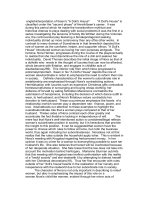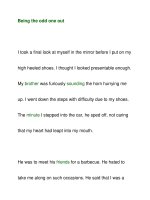a closer look at the animal kingdom
Bạn đang xem bản rút gọn của tài liệu. Xem và tải ngay bản đầy đủ của tài liệu tại đây (21.75 MB, 89 trang )
Published in 2012 by Britannica Educational Publishing
(a trademark of Encyclopædia Britannica, Inc.)
in association with Rosen Educational Services, LLC
29 East 21st Street, New York, NY 10010.
Copyright © 2012 Encyclopỉdia Britannica, Inc. Britannica, Encyclopædia Britannica, and the
Thistle logo are registered trademarks of Encyclopædia Britannica, Inc. All rights reserved.
Rosen Educational Services materials copyright © 2012 Rosen Educational Services, LLC.
All rights reserved.
Distributed exclusively by Rosen Educational Services.
For a listing of additional Britannica Educational Publishing titles, call toll free (800) 237-9932.
First Edition
Britannica Educational Publishing
Michael I. Levy: Executive Editor, Encyclopædia Britannica
J.E. Luebering: Director, Core Reference Group, Encyclopædia Britannica
Adam Augustyn: Assistant Manager, Encyclopædia Britannica
Anthony L. Green: Editor, Compton’s by Britannica
Michael Anderson: Senior Editor, Compton’s by Britannica
Sherman Hollar: Associate Editor, Compton’s by Britannica
Marilyn L. Barton: Senior Coordinator, Production Control
Steven Bosco: Director, Editorial Technologies
Lisa S. Braucher: Senior Producer and Data Editor
Yvette Charboneau: Senior Copy Editor
Kathy Nakamura: Manager, Media Acquisition
Rosen Educational Services
Alexandra Hanson-Harding: Editor
Nelson Sá: Art Director
Cindy Reiman: Photography Manager
Matthew Cauli: Designer, Cover Design
Introduction by Alexandra Hanson-Harding
Library of Congress Cataloging-in-Publication Data
A closer look at the animal kingdom / edited by Sherman Hollar.
p. cm.—(Introduction to biology)
“In association with Britannica Educational Publishing, Rosen Educational Services.”
Includes bibliographical references and index.
ISBN 978-1-61530-580-3 (eBook)
1. Animals—Classification—Juvenile literature. I. Hollar, Sherman.
QL351.C59 2012
590.1'2—dc22
2011010406
On the cover: An elephant, the largest living land animal, is seen against the sweeping background at
Kilimanjaro, northern Tanzania, Africa. Shutterstock.com.
Interior background images Shutterstock.com.
C ON TE N TS
IntroductIon
chapter1theVarIetyofanImallIfe
t VarIety
6
12
chapter2classIfIcatIonandBehaVIor
class cat on
33
chapter3anImalswIthoutBackBones
a
50
chapter4anImalswIthBackBones
a
B
61
75
77
80
83
84
conclusIon
Glossary
formoreInformatIon
BIBlIoGraphy
Index
INTRODUCTION
A
nimals are everywhere. Even busy
New York City, full of cars and
concrete, is teeming with animal
life. Ants march up a sidewalk. Pigeons
peck at crumbs, while squirrels search for
nuts. A horse drawing a carriage trots by
Boston terriers dragging their owner to
the dog park. A gray rat skitters across subway tracks while a cat stares down from a
skyscraper at tiny taxis and people below.
No matter where you live, you will be surrounded by animals—including human
beings! This book will help you learn more
about your fellow members of the animal
kingdom.
There are more than ten million kinds
of animals in the world, and about 1.3 million have been identified by scientists. All
life forms started in the same place: in the
oceans some 3.5 billion years ago. Our common ancestors were simple single-celled
organisms. Over time, many living things
became more complex as they adapted
to various environments. Multicellular
organisms began to form and separate into
different species as they moved. Some
moved into freshwater, others to land.
6
IntroductIon
Members of the kingdom Animalia are
different from all other living things on
Earth. We are eukaryotes, which means that
our cells have various complex parts such
as a nucleus and organelles. (Bacteria and
archaea are made up of simpler prokaryotic cells.) But unlike plants, which are also
eukaryotes, we cannot make our own food
through the process of photosynthesis—
animals must rely on eating vegetation and
other animals to survive. Animals are metazoans (the prefix meta- means many) because
they are made of many cells. (Single-celled
animal-like creatures are called protozoa.)
Scientists who study animal life classify
animals based on their bodies. That helps
scientists decide how animals are related to
others. One of the most important ways of
classifying animals is by whether they are
invertebrates (who lack a backbone) or vertebrates (who have one). Invertebrates make
up 95 percent of animal species. The first
animals were invertebrates, such as sponges
and jellyfish. About 85 percent of invertebrates are arthropods (the word means
“jointed foot”). Many arthropods have an
exoskeleton made of a substance called
7
A closer look At the AnImAl kIngdom
Cygnets (baby swans) walk in the rain at Abbotsbury Swannery in
Caption TK England. The swannery is home to a herd of 800 wild
Weymouth,
swans. Matt Cardy/Getty Images
8
IntroductIon
chitin.
Arthropods
include
centipedes,
spiders, scorpions, and
lobsters. Most significantly, they include
insects. More than one
million insect species
have been identified—
the largest group within
the animal kingdom.
Vertebrates are animals with backbones.
Some live in the sea,
such as fish; others
live on land; others,
like birds, take to the
air. They make up only
about 5 percent of all
animal species. The
complexity of their
bodies lets vertebrates
have bigger, more complex brains. The most
advanced vertebrates
are mammals. Only
5,000 species of mammals exist. The blue
whale is a mammal
that is the largest living
9
A closer look At the AnImAl kIngdom
creature on Earth. It can grow to be more
than 100 feet (30 meters) long and weight
300,000 pounds (136,000 kilograms).
Scientists also study how animals adapt
to their environments. While some animals
are solitary, others are more social. Bees live
in hives. Wolves live in packs. Some build
homes. Groundhogs live in complex underground burrows with connecting tunnels.
Other animals have adapted themselves to
live with humans, such as our closest companions, dogs.
No doubt about it, animals large and
small—including us—adapt themselves to
survive in many different ways. This volume
will help you to understand and identify
the animals that live around you—whether
you’re in a bustling city, a quiet suburb, or
out in the country—and those that populate our planet.
10
C hapter 1
The Variety of Animal Life
L
iving things are divided into three
main groups called domains. Singlecelled organisms called bacteria and
archaea each constitute their own domain.
All other organisms make up a third domain,
Eukarya, which includes not only singlecelled algae and protozoa but also animals
and other multicellular organisms. Animals
form the largest group within the Eukarya.
They range from very simple invertebrates,
such as sponges, to highly complex mammals, such as whales, monkeys, and humans.
Animals display some key differences that
distinguish them from other living things.
For example, what is the difference between
an animal such as a horse and a plant such as
grass? A horse moves around in the pasture
eating grass. It trots toward you when you
offer it a lump of sugar and reacts favorably
when you stroke its head. The grass, however,
is rooted to one place. It does not respond
behaviorally to people or to the horse in any
A horse eats grass in Oxfordshire, England. Tim
Graham Photo Library/Getty Images
12
the VArIety of AnImAl lIfe
13
A closer look At the AnImAl kIngdom
way. More importantly, plants use nutrients
from the soil and chemical reactions from
the sun to make their own food. This process
is called photosynthesis. Animals cannot
make their own food—to survive, they have
to eat plants or other animals.
Scientists estimate that there may be
more than ten million different kinds of animals on Earth today. About 1.3 million kinds
have been identified to date, and new kinds
are continually being discovered. In the seas,
from the surface down to the black depths
where no ray of light penetrates, on mountaintops and in deserts, in mud and in hot
pools, some form of animal life may be found.
Animals are extremely varied in form,
size, and habits. The smallest animals, such
as the crustaceans called copepods, are so
tiny that they can barely be seen without a
microscope. The largest, the blue whales,
may be more than 100 feet (30 meters)
long and weigh 300,000 pounds (136,000
kilograms).
Some of the most familiar animals, such
as dogs, birds, frogs, and fish, have a backbone and a central nervous system. They are
called vertebrates, meaning animals with
spinal columns or backbones. Animals without backbones are called invertebrates and
14
the VArIety of AnImAl lIfe
include arthropods, worms, mollusks, and
many other groups.
Vertebrates and most invertebrates have
a head, where sense organs are concentrated
and legs, wings, or fins for locomotion.
Vertebrates and many invertebrates, such as
the arthropods and worms, have bilateral, or
two-sided, symmetry. This means that they
have two mirror-image sides (a right side and
a left side), distinct upper and lower surfaces
of the body, and a distinct front and rear.
Some invertebrates, such as jellyfish, sea
anemones, and sea stars, or starfish, display radial symmetry, similar to that of a
wheel, in which the parts of the body are
arranged around a central axis. Animals with
radial symmetry live in marine or freshwater aquatic environments. Some drift with
the currents, unable to swim in any definite
direction. Others become attached to a solid
object by one end and float with the mouth
end upright. Tentacles arranged in a circle
around the mouth sweep in food particles
and ward off enemies.
How Invertebrates Move
Mollusks have soft bodies that are in most
species enclosed in hard, hinged shells. Snails
15
A closer look At the AnImAl kIngdom
have a single large, fleshy foot that can extend
outside its shell. Oysters, clams, mussels, and
scallops also have a single muscular foot that
they use to burrow into sand. These mollusks
do not move around efficiently. Oysters fasten themselves to something solid and settle
down for life, letting food drift to them.
Scallops may move in a zigzag motion by clapping their shells together. The octopus and
A grasshopper rests on a car roof in South Africa. Paul Ellis/AFP/
Getty Images
16
the VArIety of AnImAl lIfe
the squid have a head that is surrounded by
a circle of eight or ten tentacles, respectively,
that act as arms and feet. They use jets of
water to propel themselves through the water.
Joint-legged animals, or arthropods, have
bodies divided into segments that have specialized functions. These animals also have
many jointed legs. Most arthropods are covered with a jointed skeleton made of a horny
material. This outside skeleton is lighter than
the shells of the mollusks. The legs and muscles and many organs of the arthropod are
attached to the outside skeleton.
The arthropods include insects, such as
houseflies and ladybugs; crustaceans, such
as lobsters, crabs, and copepods; arachnids,
such as spiders, scorpions, and ticks; and
other organisms, such as centipedes and millipedes. Arthropods can run, jump, swim, and
crawl. Some live mostly on land, while others
live mostly in water. Many of the insects have
wings and can fly.
How Backboned
Animals Move
Many vertebrates can move through water
and air or over the ground with great speed
17
A closer look At the AnImAl kIngdom
and skill. Birds, with their feathered wings,
are the best fliers. Fish are the best swimmers. However, other vertebrates also
can fly and swim. Bats fly on wings made
of a skinlike membrane. The flying squirrel glides by using a broad membrane that
lies between its legs, and the flying fish can
A kangaroo shows its ability to jump as it flees a bushfire in
Australia’s Kiewa Valley on February 11, 2009. Torsten Blackwood/
AFP/Getty Images
18
the VArIety of AnImAl lIfe
soar over the surface of the ocean by using
its fins; however, neither can move very far
through the air.
A number of mammals are good swimmers, including whales, which spend their
entire life in the ocean, and seals, which
also spend time on land. Some turtles swim
with paddlelike front legs, and some water
birds can swim underwater with their wings.
The mudskipper and walking catfish are fish
that can walk on mud by pulling themselves
along on their front fins.
Frogs, kangaroos, and various cats are
superior jumpers. Some fish are also able to
jump. Salmon leap up waterfalls when they
travel from the sea to their home streams to
lay their eggs. Tarpon, swordfish, and sailfish make great leaps out of the water when
pursuing their prey or trying to escape
an enemy.
Breathing
All animals must take in oxygen in order to
change food into a form that the body can
use. Some animals that live in water absorb
oxygen directly into their cells. The sponge,
a very simple animal, is a good example. The
19
A closer look At the AnImAl kIngdom
surface of a sponge is covered with millions of
tiny pores. Water that bears dissolved oxygen
and minute food particles flows in through
the pores and is discharged from an opening
at the top of the sponge.
Fish and tadpoles (amphibian larvae)
breathe by means of gills. Caterpillars and
adult insects take air into the body through
breathing pores called spiracles.
Mammals, birds, and reptiles obtain oxygen from the air. They take air into the lungs,
and the oxygen passes into red blood cells
through membranes in the lungs. The bloodstream then carries the oxygen to all parts of
the body. Adult amphibians have lungs, but
they also have thin, moist skins that absorb
oxygen directly.
Reproduction
All animals can reproduce, creating offspring of their own kind. Some simple
animals reproduce asexually, in which a
mating partner is not needed. Sea squirts,
for example, reproduce by budding: lumps
appear along a branchlike organ and develop
into young sea squirts. Sea squirts, sponges,
corals, and other organisms that bud often
remain together and form large colonies.
20
the VArIety of AnImAl lIfe
Reproductive Facts of
Common Mammals
21
A closer look At the AnImAl kIngdom
The hydra also reproduces by budding, but
in time the young bud separates and goes off
to grow and live alone.
In sexual reproduction, a male and a
female organism each contribute toward creating offspring. Most animals reproduce by
means of eggs from the female that are fertilized by sperm from the male.
The fertilized eggs of some species are
deposited in a nest or in some other manner
before hatching. Most species of mammal
and some species of reptile and fish bear their
young alive—the fertilized eggs develop
within the body of the female.
The types of reproductive behavior
among animals are almost as varied as the
kinds of animals themselves. Some species,
such as most insects and turtles, deposit
their eggs and give them no further attention. In contrast, social insects, such as
ants and bees, form colonies in which a
single female lays all of the eggs, and workers provide care and nourishment for the
developing young in the nest. The females
of some reptiles, such as the king cobra
and the blue-tailed skink, and amphibians,
such as the marble salamander, stay with
their clutch of eggs until they hatch but
22
the VArIety of AnImAl lIfe
Two German cockroaches mate end-to-end. Bates Littlehales/National
Geographic Image Collection/Getty Images
provide no protection or nourishment for
the young. Some fish guard their young after
they are born. Crocodilians protect the
eggs before hatching and the young for several months afterwards. Many birds provide
not only protection but also nourishment
for the developing young. Mammals, which
23
A closer look At the AnImAl kIngdom
feed their young with milk produced by the
mother, provide care for their young much
longer than do other animals.
Homes
Many animals build temporary or permanent homes for themselves and their young.
Birds occupy their nests only while they are
incubating eggs and feeding the helpless
nestlings. A few fish make temporary nests
for their young.
One notable animal dwelling is the waterprotected lodge that beavers build. Almost
as remarkable is the dome-shaped winter
home of the muskrat. Underground burrows
with sleeping rooms, food-storage rooms,
connecting tunnels, and emergency exits are
constructed by groundhogs, prairie dogs,
European rabbits, gophers, kangaroo rats,
and field mice. Chimpanzees and gorillas
build temporary nests and sleeping platforms of sticks in trees. The living quarters
made by the different kinds of ants can be
intricate and complex. Certain tropical bats
cut palm fronds in such a way that they droop
to form a leafy shelter from the hot sun and
torrential rains.
24









